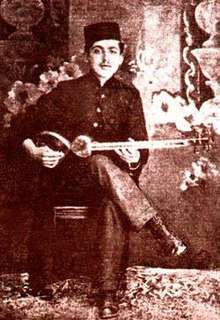Morteza Neidavoud
Morteza Neidavoud (Persian: مرتضی نیداوود) (1900–1990) was a prominent Iranian musician.[1]
Morteza Neidavoud مرتضى نى داوود | |
|---|---|
 | |
| Background information | |
| Born | 1900 Isfahan,[1] Iran |
| Died | 1990 (aged 89–90) San Francisco,[1] United States |
Early life and education
Morteza Neidavoud was born in Isfahan to an Iranian Jewish music-loving family.[1] His musical gift was revealed at childhood.[1] His father Bala Khan, who was a musician himself and played the tonbak, wanted to see his son enroll into a different field, and was thus initially against him becoming a musician.[1] However, realizing his natural talent and determination, he eventually took him to see Ramazan Zolfaghari, a musician who was a student of Aqa Hosseinqoli.[1]
Neidavoud was trained by Zolfaghari for a short while and then he went to Aqa Hosseinqoli to learn from the master musician himself.[1] Neidavoud learnt with Hosseinqoli until the latter's death in 1916.[1] He then went on to learn music from Darvish Khan who was a famous student of Mirza Hossein-Qoli.[1] During this time he picked up on playing radif and then the tar. At the end of three years he received the symbolic Golden Battle-Axe, awarded to outstanding students.[1]
Career
In early 1925 he founded a class to teach the Iranian Tar and Radif. He named the school Darvish in honour of his master, who had died in 1926.[1]
His acquaintance with Qamar-ol-Moluk Vaziri at a private celebration led to the discovery of one of the greatest Iranian singing talents. The two continued to co-operate and as Qamar learned from him, she performed many of her famous songs. Since 1927, most of Qamar's lyrics and songs have been accompanied by Morteza Neidavoud.
Following the establishment of the radio, Neidavoud worked with the broadcasters just like other artists did. Some being Reza Mahjoubi, Ali Akbar Shahnazi, Habib Samayi, Abolhassan Saba and Musa Maroufi. He had either wrote lyrics or composed for famous singers such as Qamar-ol-Moluk Vaziri, Maluk Zarrabi, Ruhangiz, Adib Khansari, Javad Badi Zadeh and Gholam Hossein Banan.
Notable works
References
Sources
- Dehkordi, Morteżā Ḥoseyni (2005). "NEY-DĀWUD, Morteżā". Encyclopaedia Iranica.CS1 maint: ref=harv (link)
External links
- Sarshar, Houman (2010). "Naydāvūd, Murtażā Khān". In Norman A. Stillman (ed.). Encyclopedia of Jews in the Islamic World. Brill Online.CS1 maint: ref=harv (link)
- "يادی از مرتضی نی داوود، خالق آهنگ مرغ سحر". BBC Persian Television (in Persian).